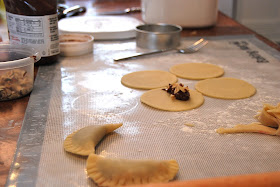
In my last post, I showed you what can happen if you use the wrong type of leavener in a cake. To recap, I used baking powder instead of baking soda in this devil's food cake recipe. But then I realized that another great devil's food cake recipe (which I used for the homemade Ring Dings) used baking powder as its leavener. I was confused for a minute, but then realized there was another difference in the two recipes - each recipe specified a different type of cocoa.
There are two different types of cocoa - natural and alkalized, also known as Dutch-processed. Dutch-processed cocoa is darker in color and is harder to find in stores, but easily found online. Hershey's Special Dark cocoa, which is generally more available, is a combination of natural cocoa and a very heavily Dutched cocoa which makes it even darker (sometimes called black cocoa). Black cocoa is the cocoa that is used to make Oreo cookies.
I won't go into all the details here, but in general, natural cocoa reacts with baking soda and Dutch-process cocoa reacts better with baking powder. The devil's food cake made for the Ring Dings called for Dutch-processed cocoa, therefore using baking powder. The batter made for the cake called for natural cocoa, therefore using baking soda as the leavener.
It is still confusing though. The Baked cookbook that I bake a lot from, says not to get too hung up on the type of cocoa, just use one that smells richly of chocolate and has a nice deep color. However, their recipes call for a "dark unsweetened cocoa" (most darker cocoas are dutched) and they do mention that they primarily use Valrhona cocoa (found at Whole Foods or online) which is a dark Dutch-processed cocoa.
{As a side note: Often there is value in reading the front section of a cookbook and not just the recipes because you obtain information on the brands or types of ingredients the author used and the methods used to make the recipe a success. Ingredients, methods, and equipment can make a big difference.}
In the picture above, I have taken the four (!) kinds of cocoa I had in my pantry. They happen to be the types most commonly found in the grocery stores in my part of the world. You can see, there is quite a difference in the color of the dry cocoas. Oddly, the Ghirardelli natural cocoa and the Rodelle Dutched cocoa were almost identical, and the two natural cocoas were quite different looking.
I took a little of each cocoa and mixed it with a tablespoon or two of hot water and then compared the difference in color again. This time, the natural cocoas were most similar, the Dutched cocoa was slightly darker, and the black cocoa remained the darkest of the four.
Then I took a little taste of each. I have to say that I preferred the Dutched cocoa to the other three, but the difference wasn't that remarkable. The black cocoa was the most bitter tasting.
So what if a cake recipe doesn't specify which cocoa to use? It may have a little of both leavenings or, in recipes that call for less than 3/4 cup of cocoa, it may make less of a difference. In non-leavened recipes like those for chocolate sauce or custards, you could swap one kind of cocoa for another without any worry.
In short, I keep both natural and Dutched cocoas in my pantry and I'll be sure to use the kind the recipe specifies. And I'll try not to be distracted when following a recipe and use the right leavener too! Now I know that I have two great recipes for Devil's Food Cake, so if I run out of one kind of cocoa, I'll just use the recipe that calls for the other kind.































